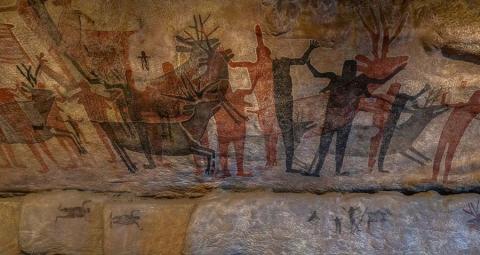A perplexing question that often arises is: why did our ancestors undertake chthonic journeys into the deepest bowels of the earth to express themselves through art against the uneven walls of the darkest caves? Why not paint rock art in more accessible locations? Scientists have recently discovered that the rock artists braved descending into these almost inaccessible caves because they discovered they were acoustic ‘hot spots’ where sound reverberated more strongly. The cave art may, in turn, represent the sounds that the humans uttered in those caves. It may also have been that these caves functioned as prehistoric auditoriums, suited for story-telling – where the art served to illustrate the story. Or could it be linked to human cognitive development?
Linguist Shigeru Miyagawa, a professor of Japanese Language and Culture at MIT, and his colleagues from Tokyo and Brazil refer to the convergence of sound and art as a cross modality information transfer, which enhanced humans’ higher cognitive ability to express symbolic or abstract thinking.
Like animals, humans need to communicate with each other to fulfil their essential survival needs such as hunger, safety, and procreation, but also higher needs such as tribal bonding, love, and tenderness. Humans want to share experiences with others for the sake of sharing. Unlike other animals, humans developed the cognitive skill of language. Our species is estimated to be about 200,000 years old and human language is often considered to be at least 100,000 years old. Professor Miyagawa notes it is very difficult to try to understand how human language itself appeared in evolution but concedes that cave drawings may signal the beginnings of Homo sapiens as beings capable of symbolic expression.
Cave art has been discovered on every continent of the world and the geometric engravings on pieces of ochre at the Blombos Cave site in South Africa, dated to be at least 70,000 years old, indicate a cognitive capacity that humans took with them as they migrated to the rest of the world. Some 90 percent of cave drawings involve hoofed animals, which could symbolize the sound of hoofbeats, stampedes of animals, or they could have been part of rituals. Rituals are often accompanied by chants and dancing, both producing sounds.
According to Professor Miyagawa, cave art displays properties of language in that there is action, objects, and modification, which duplicates some of the universal features of human language - verbs, nouns, and adjectives. Researchers agree that this hypothesis needs further development of the syntax of visual representations. A long-term timeline of cave art may prove fruitful in determining if it played a pivotal role in the development of human language – a higher brain function distinguishing humans from animals.
By Micki Pistorius




